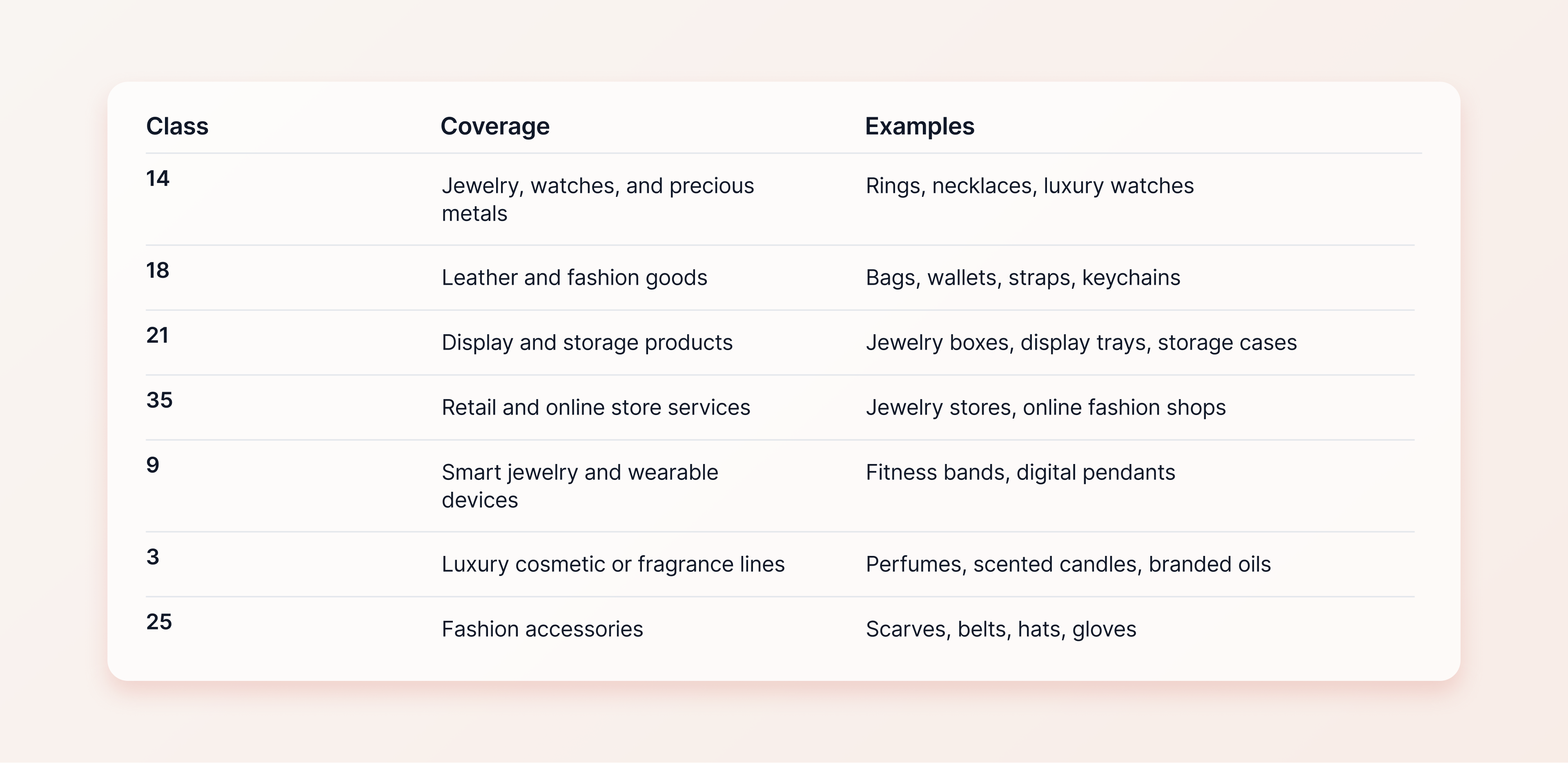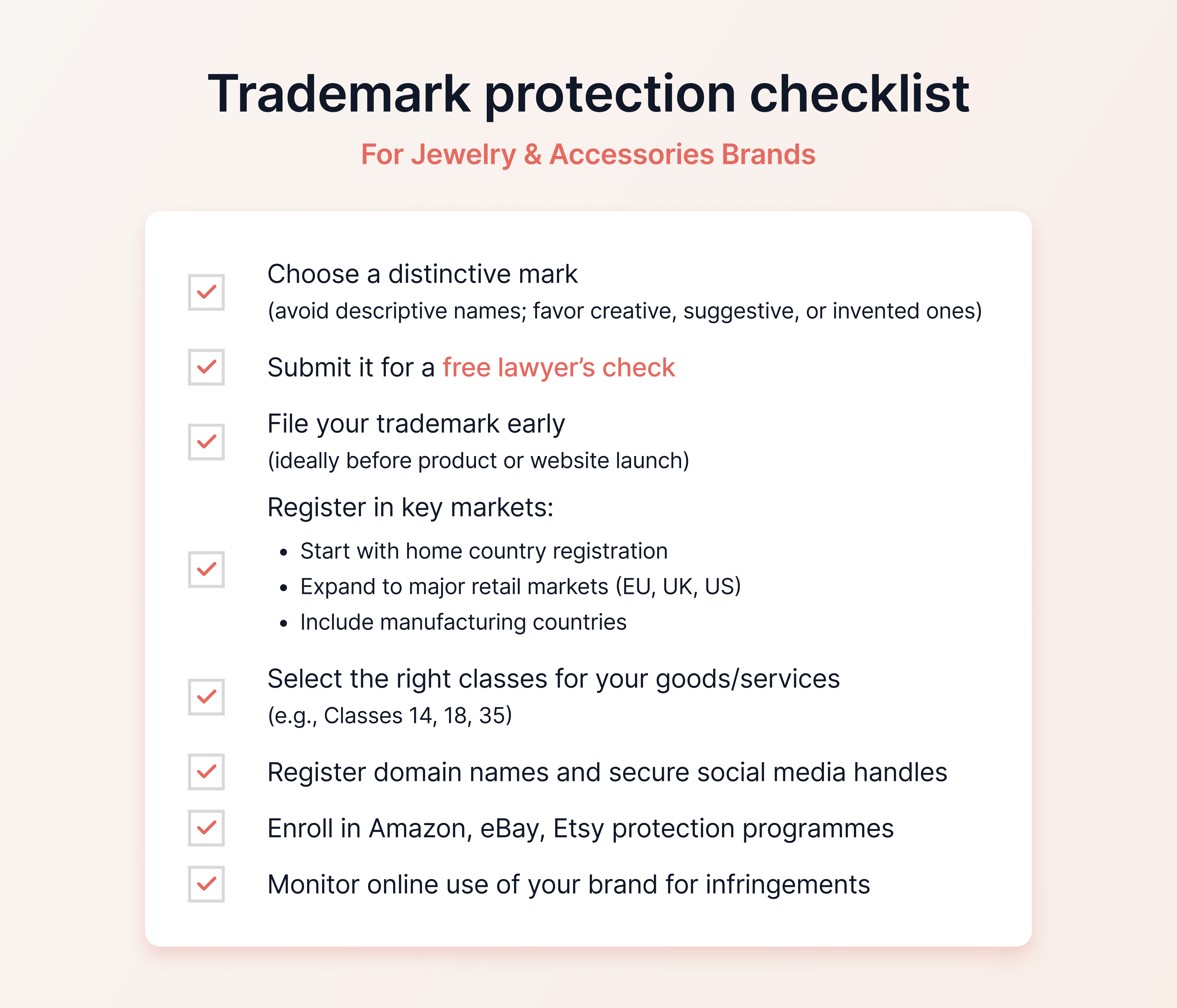Why trademarks matter in the Jewelry & Accessories industry
Every beautiful piece of jewelry starts with craftsmanship, but it is the brand that gives it meaning and emotional value.
Your brand is the name engraved on the clasp, the logo on the packaging, and the promise of quality and style that your customers associate with each purchase. It is what transforms a product into a symbol of identity and trust.
A registered trademark turns that brand from a creative expression into a legally owned asset. It gives the owner the exclusive right to use and license the name, logo, or design and provides a strong legal foundation for enforcement against imitation.
For businesses within the jewelry and accessories sector, this protection delivers real advantages. It helps you
Build customer loyalty by showing that your brand is established and authentic.
Avoid legal disputes with other designers or retailers using similar names or logos.
Expand into new collections, stores, or online platforms without losing control of your identity.
For a deeper look into why trademarks are so important for jewelry and accessories businesses, read the full article: 12 good reasons for jewelry brands to register a trademark
Best trademark practices for the Jewelry & Accessories industry
1. Choose a distinctive mark
The jewelry market thrives on artistry and individuality. Choose a brand name that reflects your creative vision rather than describing your materials or styles. The more distinctive your mark, the stronger and easier it is to protect.
Tip: Suggestive, abstract, or invented names tend to offer the best long-term protection (for example, Pandora, Swarovski, or Mejuri).
2. Conduct clearance searches
Before you engrave, produce packaging, or build a website, check that no one else has registered or applied for a similar name in your market. A legal team can help you evaluate risk and adjust your branding if necessary. This step is essential even for small designers or boutique jewelers.
Tip: Trama offers a free lawyer’s check with results delivered within 24 hours, followed by expert guidance on the next steps for registration.
3. Register early and strategically
Trademarks are granted on a “first to file” basis in most countries. If someone else files before you, you could lose your rights even if you have been using the name longer.
Action point: File for protection as soon as you can, ideally before your public launch, trade fair debut, or online release.
In which countries should Jewelry & Accessories businesses register?
The ideal trademark strategy depends on your production, retail, and growth plans. The key principle: protect your brand wherever it creates or captures value.
1. Your home market
Your first registration should always be in your country of origin, where your business is incorporated and primarily operates. This provides a legal foundation and supports enforcement at the local level.
2. Key export and expansion markets
If you sell internationally or plan to expand within the next two to three years, register in those markets before signing distribution or retail agreements.
Common priorities for jewelry and accessories exporters include:
The European Union (EU): One EU trademark (EUTM) covers all 27 member states.
The United Kingdom: Separate from the EU since 2021; requires its own filing.
The United States, Canada, and Australia: Important markets for luxury and lifestyle products.
Emerging markets with strong consumer demand (for example, China, Japan, UAE, Singapore, India).
3. Manufacturing and supply chain territories
If your products are produced or assembled abroad, for example manufacturing in Thailand or Italy, register your mark in those countries as well. This prevents local manufacturers or distributors from misusing or registering your brand.
4. Digital and cross-border commerce
Jewelry and accessories brands often reach customers globally through e-commerce and social media. Competitors or counterfeiters in other countries may try to register your mark first. If you sell internationally through your website or marketplaces, extend protection to the countries you most frequently ship to or promote in.
In what classes should Jewelry & Accessories businesses register?
Selecting the correct trademark classes is as important as choosing the right jurisdictions. Trademark protection is class-specific: it applies only to the goods and services covered in your application.
The Nice Classification system (adopted globally) divides goods and services into 45 classes. For the jewelry and accessories industry, the following are typically relevant:

A precise class selection provides strong coverage and minimises gaps that competitors might exploit. A trademark lawyer can assess your operations and future plans to ensure comprehensive and commercially sound protection.
For detailed class guidance and tailored recommendations, use our online tool: Trademark Class Assist
How to protect your Jewelry & Accessories brand online?
Operating online offers immense exposure but also increases the risk of imitation. Here is how to protect your trademark effectively across the internet:
1. Domain names
Register your main domain name and close variations across multiple top-level domains (for example, .com, .co.uk, .eu). Trademark registration strengthens your position under the Uniform Domain-Name Dispute-Resolution Policy (UDRP), allowing you to reclaim domains registered in bad faith by third parties.
2. Social media platforms
Secure your brand handle across all major social media platforms, even those you do not currently use.
Platforms such as Instagram, TikTok, Facebook, Pinterest, LinkedIn, and X (Twitter) have trademark complaint procedures that allow removal of infringing profiles or content. Verified profiles also act as public proof of authenticity.
3. Online marketplaces
If you sell jewelry or accessories online, participate in brand protection programmes offered by major platforms:
Amazon Brand Registry
eBay VeRO (Verified Rights Owner) Programme
Etsy Intellectual Property Infringement Reporting
TikTok Shop IP Protection Center
These programmes help verify brand ownership and enable you to remove counterfeit listings or misleading sellers more efficiently.
4. Digital advertising and SEO
Competitors sometimes use another brand’s name in online advertisements or metadata to redirect traffic. With a registered trademark, you can request the removal of such ads under Google’s or Meta’s advertising policies.
5. Ongoing monitoring and enforcement
Regularly monitor search results, online reviews, and marketplace listings for misuse of your brand name, logo, or product imagery.
Trademark monitoring tools, or professional services such as Trama, can alert you to new filings or suspicious uses globally, allowing you to act within legal time limits.
Final thoughts
Every jewelry and accessories brand lives through the emotion and experience it creates for customers. Protecting that experience through trademark registration is both a legal safeguard and a business advantage.
Many designers and jewelers invest heavily in craftsmanship, packaging, and marketing before securing legal protection. A trademark lawyer can help design a protection strategy that aligns with your business goals, providing both legal strength and commercial flexibility. To make sure your brand is fully protected as you grow, you can start your registration here.
Free Checklist



